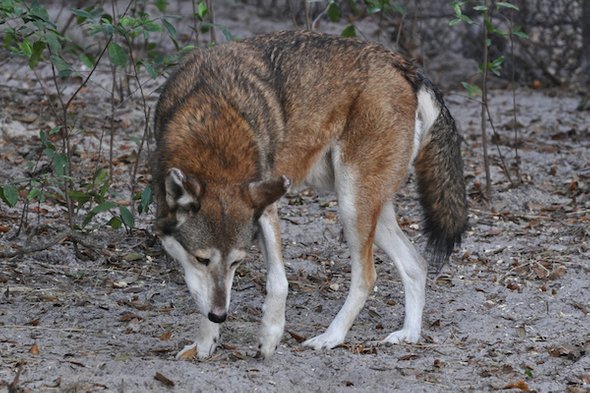
April was a roller-coaster month for the world’s rarest wolves.
On April 21 the Museum of Life and Science in Durham, N.C., announced that its female red wolf (Canis rufus) had given birth to a trio of adorable pups. Only about 220 red wolves exist in captivity, with the animals spread around the country among 43 institutions, so every birth tends to be cause for celebration.
This time, sadly, there wasn’t much opportunity for joy. Just four days later, on April 25, the U.S. Fish and Wildlife Service announced that the wild population of red wolves had crashed to about 40 individuals, including just three breeding pairs. That’s down from about 120 wild wolves in 2013.
Why this sudden, precipitous decline? It all started in 2012, when North Carolina introduced a new state rule that allowed night hunting of coyotes, which are often considered to be pests. That put the wolves, which are a bit bigger than coyotes and have been known to cross-breed with them, directly in the crosshairs. Since that rule went into effect dozens of the animals have been accidentally—and in some cases, it appears, intentionally—killed by bullets, private trappers or poisonings. Others were killed after being struck by vehicles, an unfortunately side effect of their once-growing and dispersing population
The decline is now so severe that the Service’s report warns the few remaining wolves in the wild could be completely gone in as little as eight years. “The red wolf does not have the adequate numbers or multiple resilient populations needed for the species” to persist in the wild, according to the report.
The news marks a dramatic turn in the conservation of red wolves, a species which has already been saved from extinction once before. Red wolves nearly disappeared in the last century after decades of hunting by farmers trying to protect livestock. The final 14 purebred wolves were brought into captivity for a breeding program that started in 1969, and every red wolf that lives today is descended from those few animals. The wolves living in the wild, all of which are in North Carolina, came from that founding population and an experimental reintroduction program which began in 1992.
Now that experiment appears to be failing, leaving the hope for the species once again on the captive-breeding program.
“What we’re doing in the captive populations is more critical than ever before,” says Sherry Samuels, animal department director for the Museum of Life and Science, one of institutions participating in the captive-breeding program.
That comes with its challenges. Captive breeding, it turns out, is not as easy as just putting males and females together in the same enclosure. It takes a little more planning—and a fair amount of luck.
Life—and Breeding—in Captivity
The most important part of captive breeding, Samuels says, is genetics.
With such a small founder population, it’s essential to make sure potential breeding partners aren’t too closely related to each other. “You’ve got a pretty limited gene base to start,” she says.
As an example, she points to the two wolves that gave birth to four pups at the museum in 2017. The North Carolina museum has limited room, so all six wolves were transferred to the much larger Wolf Conservation Center in New York, where the parents had four more pups. “Those 10 offspring, genetically speaking, are identical. There are about 220 wolves in the captive population, so those 10 pups genetically make up five percent of it.”
Those 10 pups, once grown, will need to be found partners that expand the next generations’ genetic health. The Red Wolf Species Survival Program, which maintains the red wolf stud book and meets once a year to determine the wolves’ breeding requirements, shuffles animals among facilities in order to maintain future genetic diversity.
Other considerations come into play. For one thing, younger females may get prioritized as potential mothers. “The reproductive research is showing that it’s very important to try and breed these young females,” Samuels says. “Otherwise they may not breed when they’re older.”
Beyond that, some wolves possess rarer genes that need to be preserved in the larger population. “If you have some wolf that’s underrepresented, you try and breed them, find a good match and keep trying.” Even if those wolves become older, they may still be prioritized when the Species Survival Program establishes each year’s pairs.
Of course, picking genetics isn’t the same as choosing a mate. Sometimes paired wolves just don’t cooperate with their human-generated dating algorithms. “We had eight years, from 2009 to 2016, where we had a breeding pair of red wolves here at the museum but didn’t have pups,” Samuels says. That doesn’t mean those wolves will never become parents. One male wolf, which had been paired with two females unsuccessfully, was moved from North Carolina to a facility in Washington, where he had pups with his new mate the very next year.
“Some of it is just finding the right match,” Samuels says.
Space: The Limiting Frontier
Despite these challenges the red-wolf breeding program works. Samuels says about 20 to 25 percent of the paired wolves give birth each year, a pretty good success rate for such an endangered species.
But that brings up another problem. Outside of genetics, the most limiting factor for red wolves in captivity is simply lack of space. These are fairly large carnivores — slightly smaller than gray wolves — that require a minimum of about 5,000 square feet each in which to move around. “Zoos, museums and nature centers inherently have smaller exhibits compared to what they’d experience in the wild,” Samuels says. “We don’t have unlimited space. Last year we had a family of six living in an exhibit that was built for two, maybe three wolves.”
That’s a problem across the board. “There’s nowhere to move pups,” she says. “There’s no extra space out there right now.”
That’s especially true now that all pups born in captivity currently stay in captivity. Until a few years ago, some pups used to be placed in the wild to supplement the experimental population. Samuels says that cross-fostering program “was a huge success, and the first of its kind for any carnivore.” Unfortunately reintroductions stopped in 2015 while the Fish and Wildlife Service began to reassess the program, a process that culminated in last month’s bad-news report.
Health and Tragedy
Even if there’s no current plant to let captive-born wolves leave captivity, they are still managed as if they are wild animals. The facilities don’t engage in what’s known as operative conditioning, where zookeepers build relationships with their animals and effectively train them to take actions to enable easier feeding or health checks, such as coming to a fence or opening their mouths on command. “With the potential of release, that’s not a tool that we use,” Samuels says.
That does make it harder to do health exams on the wolves, especially the newborn pups. The pups were watched closely the first week after they were born to make sure they were gaining weight and they didn’t have any obvious health problems. “It’s just like with a human baby,” Samuels says. “Are all the parts in the right place?”
There is some risk, no matter how healthy the pups are upon birth. Pups could fall and hurt themselves, or an inexperienced parent could roll over onto them. Pups are also prone to injuries on their paws, which for the first few weeks of their lives have very tender foot pads that can become infected. In fact, two of last month’s three pups had sores on their feet the day after their birth and required treatment with antibiotic ointments.
The biggest goal, even in non-breeding seasons, is to let the wolves just be wolves and minimize stressful interactions. “You have to come up with decisions about what to do,” Samuels says. “There are pros and cons — if you go in and you treat the animals, you have to worry about the impact on the stress level for the whole family.” These are very shy animals naturally, she points out, so people going into their enclosure for any reason can be stressful. “It’s a constant balance of do we engage or not engage — and sometimes, really, less is more.”
Unfortunately red wolves experienced one more roller-coaster turn last month. One of this year’s pups, a female, died unexpectedly on April 28. The cause of her death is not yet known. “A necropsy, or animal autopsy, has been conducted and results are pending,” the museum wrote on its Facebook page. “While losses like these are difficult, they are not uncommon among red wolf litters.”
The museum has now closed its red wolf exhibit to the public in order to minimize any potential additional stress on the family. The two remaining pups appear to be doing well and were recently photographed cuddled together in a heart-shaped pose.
Ultimately, that death may be a bit of a setback to the program even beyond the loss of the pup, because keeping the exhibit open helps to drive support for the species. “How do we get people to care about red wolves?” Samuels asked me before the pup’s untimely passing. “They need to know about them, which means they need to see them having these pups here, where people can get excited about babies. Furry things are what people like. So we need to build the connection, the relationship, the understanding.”
A Powerful Responsibility, an Uncertain Future
What’s it like to work with such a rare species — one that would already have gone extinct without the hard work of small teams of people around the country?
“When I think too far ahead, it literally brings tears to my eyes,” Samuels says. “I’ve worked now with just about 40 different red wolves in my life. You know, there’re only 40 in the wild right now, and only 220 in captivity.”
Still, she’s proud of what she and her team have accomplished. “We gave them a habitat here, and they’re obviously comfortable enough to produce offspring. The museum has done something well and I’ve been part of that. That’s pretty amazing.”
She hopes to impress more people about the red wolf’s value, not just as part of a healthy ecosystem but as a uniquely American and North Carolinian species. “This is an animal that’s been here for a long time and deserves under our laws, let alone our ethical responsibility, to move forward and be protected,” she says.
Meanwhile, she discounts often-repeated criticism that too many red wolves have hybridized with coyotes and therefore the species isn’t worth saving. “If you look at the scientific papers there really isn’t much debate over the fact that this is an entity worth of protection,” she says.
As for what comes next, that’s a big question. “My hope for the future is that we can get new institutions on board really quick so we’ll have more space for red wolves,” Samuels says. She’s also hopeful that the U.S. Fish and Wildlife Service will “step up their game and do more to protect and recover the species, to do their job better both in captivity and in the wild.”
She adds that individuals can also play a big role in that future. She encourages people to contact their representatives and officials, some of whom have introduced bills to end the red wolf reintroduction program, to “tell that it’s important to keep these animals around.”
Samuels also suggests people try to witness these rare animals in person by visiting any of the 43 facilities around the United States that are keeping and breeding red wolves, most of which are open to the public.
That’s potentially more important now than ever. “If you get a chance to see them, you’re looking at something not many people have seen,” she says. “And if things don’t go well,” she adds, “they might not be here in the future.”











RSS